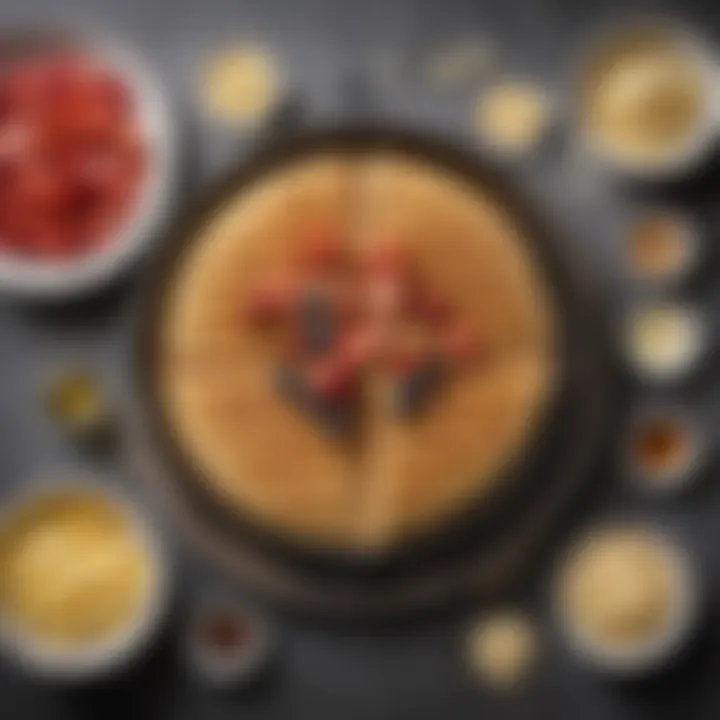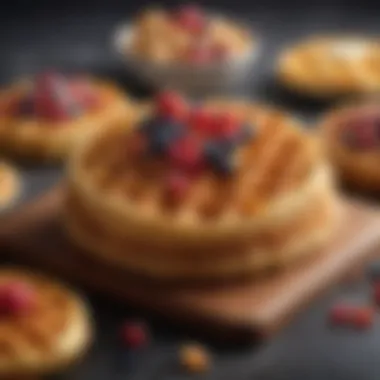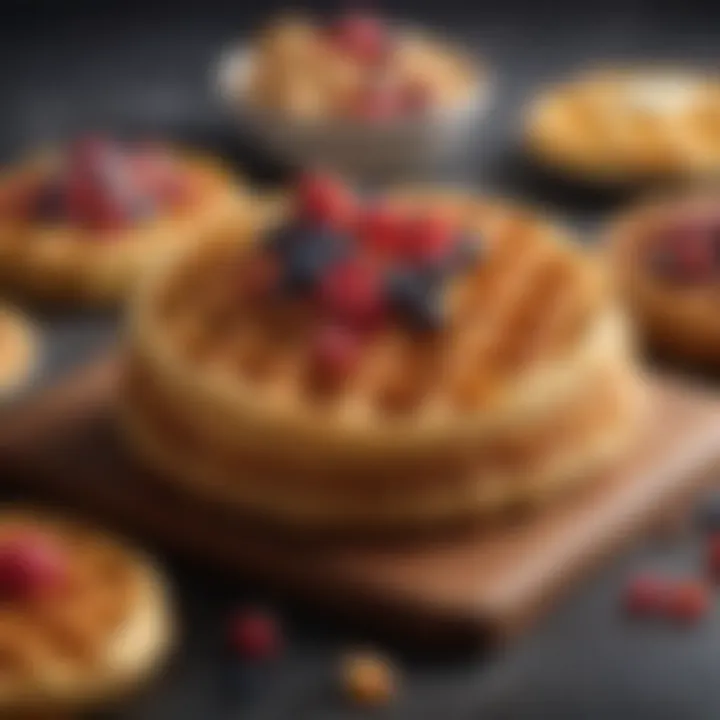Mastering Waffle Batter: Recipes and Techniques


Intro
Waffles have a special place in many culinary traditions around the world. Their simplicity belies a delightful complexity that makes them both approachable and adaptable. This guide focuses on mastering waffle batter recipes, providing essential knowledge to enhance your cooking repertoire. We will explore various fundamental recipes, discuss ingredient selections, and highlight key techniques for achieving the perfect texture in your waffles.
Understanding the nuances of waffle batter is crucial for anyone looking to cook delectable waffles, whether for breakfast or dessert. Ingredients play a pivotal role, influencing flavor and consistency. Thus, having an appreciation for the quality of components used can significantly impact the final product.
In addition, special dietary needs and taste preferences should not be overlooked. Through this guide, you will gain insights into creating gluten-free, vegan, and low-sugar variations. Innovative flavors will be featured to give your waffles a unique twist. Each recipe includes practical tips to ensure successful results.
The goal is to empower culinary enthusiasts of all ages. By mastering waffle batter preparation, you can surely craft personalized creations that please any palate.
Understanding Waffle Batter
Waffle batter is the cornerstone of making great waffles. Understanding its components is essential for achieving the desired texture and flavor. An awareness of the fundamentals can elevate one’s waffle-making skills. The batter's balance significantly influences the taste and appearance of the final product.
Overview of Waffle Types
Waffles come in various forms worldwide. Each type has unique characteristics, from texture to flavor. Belgian waffles are light and airy, while American waffles tend to be denser and crispier. Each style requires different batters, affecting preparation methods and cooking times.
Essential Ingredients
- Flour types: The choice of flour affects the structure of the waffle. All-purpose flour is a popular choice due to its versatility. It provides a balanced gluten content, giving waffles a pleasant chewiness. Whole wheat flour offers a nuttier taste and increased fiber, appealing to health-conscious individuals. However, it may yield denser waffles if used exclusively.
- Leavening agents: These ingredients create the lift in the batter. Baking powder is a common choice for light and fluffy waffles. It releases carbon dioxide when combined with liquids, causing the batter to rise during cooking. Yeast can also be used for a distinct flavor and texture but requires longer preparation time.
- Liquids: The liquid component in waffle batter dictates moisture and consistency. Milk is often used for a rich flavor and smooth texture. Alternatives like buttermilk add acidity, enhancing flavor and tenderness. Water can be a lighter option, but it may lack the depth of flavor.
- Fats: Fats, such as butter or oil, contribute to the crispiness of waffles. Butter is favored for its rich taste; however, an oil like vegetable or coconut provides a different texture. While oil increases shelf life, butter can help achieve that golden, crunchy exterior.
- Sweeteners: Sweeteners, including sugar or honey, enhance flavor. Granulated sugar is commonly used for a straightforward sweetness. Honey can bring a unique taste and moisture, but it may alter the batter's consistency. It is necessary to balance sweetness to avoid overpowering the other flavors.
Baking Tools Necessary
- Waffle iron specifications: The waffle iron is critical for the cooking process. Different models provide various textures and designs. Non-stick surfaces facilitate easy release and cleanup. Consideration of the size and shape of the waffles is also important, as this can influence presentation.
- Mixing bowls: Mixing bowls are fundamental for preparing the batter. A sturdy bowl that accommodates all ingredients without spilling can make the process smoother. A larger bowl also helps in combining dry and wet ingredients effectively.
- Measuring instruments: Accurate measurements are vital to ensure consistent results. Using measuring cups and spoons can help achieve the right ingredient proportions. A kitchen scale can provide greater accuracy, especially for dry ingredients like flour.
- Whisks and spatulas: These tools are essential for mixing the batter. A whisk helps incorporate ingredients without overmixing. Spatulas are useful for scraping down the sides of mixing bowls and ensuring all ingredients are combined evenly. Having the right tools can simplify the mixing process and improve the final product.
Core Waffle Batter Recipes
The significance of core waffle batter recipes lies in their ability to serve as the foundation for creating wonderful waffles. For anyone who wants to improve their culinary skills, mastering these recipes is essential. Each variation of waffle batter introduces unique taste, texture, and nutritional benefits. This section will outline several popular waffle batters, emphasizing the components that define their characteristics. Understanding these recipes allows one to curate a delightful experience, whether it be for breakfast, brunch, or dessert.
Classic Waffle Batter
Ingredients required
The classic waffle batter is favored for its simplicity and deliciousness. Typically, it contains all-purpose flour, baking powder, sugar, milk, eggs, and melted butter. The combination of these ingredients results in a balanced flavor and a delightful texture.
All-purpose flour is a staple in many kitchens. It has a moderate protein content that helps create a light and fluffy structure. Baking powder serves as a crucial leavening agent, promoting the rise and ensuring a crisp exterior while maintaining a soft and airy inside. Sugar not only sweetens but also aids in browning, enhancing flavors during cooking.
The richness of butter also contributes to the overall flavor and moisture of the batter. This combination makes classic waffle batter a popular choice for many home cooks.
Preparation steps
Preparation of classic waffle batter is straightforward. Start by mixing dry ingredients—flour, baking powder, sugar, and a pinch of salt—in one bowl. In another bowl, whisk together the wet components: milk, eggs, and melted butter. Gradually add the wet mixture to the dry, stirring until just combined. Avoid overmixing, as it may lead to dense waffles. This step is critical for achieving the desired lightness.
This relatively quick process makes it easy for both novice and experienced bakers to whip up a batch. The immediate availability of ingredients in most households makes this recipe practical.
Cooking instructions
Cooking the waffles requires a preheated waffle iron, which allows for uniform heat distribution. Lightly oil or spray the iron to prevent sticking. Pour in the prepared batter, filling the iron but not overcrowding it. Close the lid and cook according to the manufacturer’s instructions, generally around 3-5 minutes, until golden brown.
Monitoring the doneness is essential, as it ensures the perfect waffle. This method is effective and creates waffles that are crispy on the outside and fluffy on the inside.
Buttermilk Waffle Batter
Benefits of using buttermilk
Buttermilk is a common ingredient in many waffle recipes due to its unique properties. One significant benefit is the acidity it brings, which reacts with baking powder to create additional lift. This results in a lighter, fluffier texture.
Moreover, buttermilk adds a distinct tanginess that enhances flavor. It can balance sweetness and provide a more complex profile. The added moisture from buttermilk helps keep waffles tender, making them more enjoyable to eat. Overall, using buttermilk elevates the classic waffle experience.
Recipe variations
Exploring variations using buttermilk can yield exciting results. Some might choose to infuse flavors such as vanilla or spices like cinnamon. Others may add fruit purees to the batter for unique tastes. Each alteration caters to different palates, encouraging creativity in the kitchen.
These variations allow for a personalized waffle experience suitable for individual preferences and dietary needs, making buttermilk a versatile ingredient.
Texture differences
The texture of waffles made with buttermilk can differ significantly from those made with regular milk. They tend to have a more tender crumb, contributing to the mouthfeel. The reaction between buttermilk and the baking powder leads to a slightly airier quality that is soft yet still has a good structure.
This textural difference is crucial for discerning waffle lovers who appreciate the subtleties in their food.
Whole Wheat Waffle Batter
Health advantages
Utilizing whole wheat flour in waffle batter provides numerous health benefits. Whole wheat is higher in fiber compared to all-purpose flour, promoting digestion and satiety. It is also rich in vitamins and minerals, making it a healthier alternative for those looking to increase their nutrient intake.
Choosing whole wheat flour aligns with health-conscious decisions, appealing to consumers who value nutritious options without sacrificing taste.
Ingredient substitution
Substituting all-purpose flour for whole wheat flour does not require drastic changes in the recipe. One can utilize a 1:1 ratio when swapping, though some adjustments to liquids may be necessary.
Adapting other ingredients can also enhance the nutritional profile. For instance, adding applesauce instead of oil reduces the calorie content while maintaining moisture.
This flexibility allows even those new to nutrition-focused cooking to create wholesome meals.
Baking recommendations
When working with whole wheat batter, consider slightly increasing the liquid content. Whole wheat flour tends to absorb more moisture, so allowing for this will prevent a dry final product.
Additionally, baking at a lower temperature for a longer duration may create a more even cook throughout the waffle, improving both texture and flavor. These recommendations cater to ensuring the best outcome when baking.
Vegan Waffle Batter
Plant-based alternatives
Creating vegan waffles opens the door to numerous plant-based alternatives. Instead of eggs, a flaxseed meal combined with water can serve as a binder, providing structure. Non-dairy milk, such as almond or soy, can replace regular milk, making the batter completely plant-based.
These substitutions aim to allow everyone to enjoy waffle recipes, regardless of dietary restrictions.


Flavor enhancements
While vegan batters may seem limited, many options exist for enhancing flavor. Adding vanilla extract or plant-based yogurt can increase richness without dairy. Incorporating spices like nutmeg or cinnamon also complements the natural sweetness of the ingredients.
This focus on flavor helps ensure that vegan waffles do not compromise on taste while being health-conscious.
Baking tips
When baking vegan waffles, pay close attention to the time and temperature settings. Overcooking may result in a dry outcome, which is a common concern with vegan recipes. Regularly checking the waffles during cooking ensures optimal results.
Adjusting cooking time slightly based on the batter's moisture content can also assist in achieving the desired crispy exterior while keeping the inside fluffy.
Innovative Flavor Additions
Incorporating innovative flavor additions into waffle batter can significantly transform the overall experience of enjoying waffles. This section emphasizes the importance of creativity in cooking and how various enhancements can elevate traditional recipes. Flavor additions not only introduce new taste profiles but also allow personalization, satisfying the diverse preferences of those who enjoy waffles. By experimenting with flavors, you can discover unique combinations that resonate better with specific occasions or culinary themes.
Fruity Enhancements
Berries
Berries are a popular choice for enhancing waffle batter. Their natural sweetness and vibrant colors create visually appealing and delicious waffles. The most common berries include blueberries, strawberries, and raspberries. Each type of berry offers distinct flavors that can range from tart to sweet. These fruits can be mixed directly into the batter or used as toppings.
The unique characteristic of berries lies in their high antioxidant content and vitamins, which can make the waffles more nutritious. However, it is essential to note that excessive moisture from berries can lead to a soggy batter if not balanced properly.
Citrus options
Citrus options like lemons, oranges, and grapefruits provide a zesty twist to waffles. They add a refreshing brightness, enhancing not only flavor but also aroma. Their acidity balances the sweetness of the batter, which can be especially beneficial in rich waffle recipes.
Adding citrus zest or juice also introduces vitamins, especially vitamin C. The challenge here is the acidity; too much can overpower the other flavors. Therefore, careful measurement is crucial to achieve the right balance without compromising the overall taste.
Exotic fruits
Exotic fruits such as mangoes, papayas, and passion fruits present an excellent opportunity for adventurous waffle recipes. They offer unique flavors that can create a culinary experience unlike traditional choices. For instance, mango can bring a creamy texture that complements the fluffy nature of waffles, while passion fruit adds an exciting tartness.
Incorporating these fruits into your waffle batter enhances flavor diversity but may require adjustments in sugar levels due to their varying sweetness. Additionally, sourcing these fruits may be challenging depending on location, which could limit availability for some home cooks.
Chocolate and Spices
Cocoa powder
Cocoa powder is a staple for chocolate-flavored waffles. It adds depth and richness, contributing to a more indulgent breakfast option. Cocoa powder can blend seamlessly into the batter, providing both color and flavor. Because it is often unsweetened, adjusting sugar levels is critical to attain the desired sweetness.
Its presence is quite beneficial for chocolate lovers. However, excessive amounts can lead to a bitterness that could overwhelm the batter. A moderate approach ensures a balanced cocoa flavor without compromising the dish's overall quality.
Chocolate chips
Chocolate chips are another beloved addition that enhances waffle batter, offering bursts of sweetness. They can vary in type (dark, milk, or white), allowing for customization based on preference. Chocolate chips melt during cooking, creating a gooey center that many find appealing.
The versatility of chocolate chips makes them a common choice, but they can increase the calorie count significantly. Therefore, it's vital to consider portion sizes when incorporating them to maintain a healthier recipe.
Spice combinations
Spice combinations can deepen the flavor profile of waffle batter in a unique way. Spices such as cinnamon, nutmeg, or cardamom can introduce warmth and complexity. These spices not only enhance the taste but also offer health benefits, including anti-inflammatory properties.
The key benefit of adding spices is their ability to elevate a simple waffle to something more sophisticated. However, care must be taken not to overpower the batter with spice, as this may alienate those who prefer milder flavors.
Savory Alternatives
Cheese infusions
Adding cheese to waffle batter can produce a delightful savory breakfast option. Cheeses like cheddar or feta can create a rich, creamy taste, contrasting beautifully with sweet toppings like syrup. Cheese enhances the umami profile of the waffles, making them satisfying and hearty.
The characteristic of cheese integration comes from its melting properties, which create pleasing textures. However, it is crucial to balance flavors; too much cheese may overshadow other batter undertones.
Herb enhancements
Herbs such as chives, rosemary, or basil introduce fresh flavors that invigorate waffle recipes. Herbs can provide a savory kick to the otherwise sweet waffles, making them suitable for various meal occasions.
The key benefit of herb incorporation is bringing a garden-fresh aspect to the dish. Nonetheless, it is important to ensure that the chosen herbs complement the base batter and do not clash with additional toppings or ingredients.
Vegetable mixes
Vegetable mixes add another layer of creativity to waffle batter. Ingredients like spinach, zucchini, or bell peppers can contribute both nutrition and flavor. Incorporating vegetables can appeal to those seeking healthier options, adding fiber and essential vitamins.
The characteristic feature of vegetable mixes is texture. Careful preparation is necessary to ensure that moisture is managed, as excess liquid can impact cooking consistency. Balancing the right amount also helps in achieving the desired flavor profile without making the waffles overly dense.
Experimenting with innovative flavor additions in waffle batter allows for endless customization, appealing to both traditionalists and those seeking novel culinary experiences.
Techniques for Perfect Waffles
The art of waffle making lies in the techniques employed during the cooking process. Mastering these techniques can make the difference between an average waffle and a truly memorable one. Techniques for perfect waffles involve careful mixing, proper usage of the waffle iron, and thoughtful serving suggestions. Each technique contributes to texture, flavor, and overall enjoyment.
Mixing Methods
Maintaining batter integrity
Maintaining batter integrity refers to the careful balance of ingredients during the mixing process. This involves combining ingredients without compromising the structure and consistency of the batter. The key characteristic of this method is to keep the batter light and airy. This is beneficial because it helps to create waffles that are fluffy on the inside while still crisp on the outside.
The unique feature of maintaining batter integrity is its focus on gentle mixing. This approach minimizes air bubbles popping and ensures that the leavening agents work effectively. However, a downside is that it requires a bit more attention and patience from the cook.
Avoiding overmixing
Avoiding overmixing of waffle batter is crucial. When the batter is overmixed, gluten can develop excessively, leading to dense and chewy waffles. The key characteristic of this technique is mixing just until ingredients are combined. This choice is beneficial for achieving a light texture in the final product.
The unique feature of avoiding overmixing lies in its simplicity. It does not require much more than awareness during the mixing process. However, neglecting to mix enough can lead to lumps in the batter, which can also affect texture. Finding the right balance is essential for successful waffles.
Resting periods
Resting periods involve letting the batter sit before cooking. This technique allows for the flour to hydrate and the gluten to relax. The key characteristic of resting periods is enhanced texture of the waffle. It is beneficial as it improves the structure of the waffle, making it less rubbery.
The unique feature of resting periods is its simplicity. You just need to wait, but this step is often overlooked. Its disadvantage might be timing; if you are short on time, this might not always be feasible to incorporate.
Waffle Iron Usage


Preheating
Preheating the waffle iron is an essential step. It ensures that the batter cooks evenly from the moment it hits the surface. The key characteristic of preheating is achieving a consistent temperature. This is beneficial because it reduces the cooking time and enhances the crispness of the waffles.
The unique aspect of preheating the waffle iron is that it allows for better browning and caramelization of the waffles. A downside could be that forgetting to preheat may result in soggy waffles, as they will not cook properly.
Oiling techniques
Oiling techniques involve applying a light layer of oil to the waffle iron before cooking. The key characteristic of this technique is to prevent sticking. This is beneficial because it promotes easy release of the waffles once cooked.
The unique feature of oiling techniques is the choice of oil. Using oils with high smoke points, like canola or vegetable oil, is recommended. However, over-oiling can lead to greasy waffles, which is a downside worth noting.
Doneness indicators
Understanding doneness indicators is vital to know when your waffles are ready. The key characteristic of this is recognizing visual and auditory cues. This choice is beneficial because it prevents undercooking or overcooking the waffles, ensuring they maintain perfect texture.
The unique feature of doneness indicators is their reliance on experience. As you cook more, you will become familiar with how your waffle iron behaves. A downside is that every waffle iron can be different, so some experimentation may be necessary.
Serving Suggestions
Traditional toppings
Traditional toppings include butter, maple syrup, and whipped cream. These are time-honored choices that enhance the flavor of the waffles. The key characteristic of traditional toppings is familiarity. They are beneficial because they pair well with most waffle types, offering a comforting and satisfying experience.
The unique feature is their versatility. They can be quickly prepared and easily combined. However, they might not satisfy those looking for something innovative or different.
Creative presentations
Creative presentations refer to serving waffles in unique ways. This can involve stacking, drizzling, or garnishing with fruits. The key characteristic is visual appeal. This is beneficial as it enhances the eating experience, making it more enjoyable.
The unique aspect of creative presentations is their ability to surprise and delight. A concern may be that these presentations require more effort to achieve, which might not be feasible for everyone.
Syrups versus sauces
Syrups versus sauces involves choosing between traditional syrup or various complementary sauces. The key characteristic of this difference is flavor complexity. This choice is beneficial because it allows for a wider range of taste experiences.
The unique aspect of choosing between syrups and sauces is the opportunity for personalization. You can tailor your waffle experience to your preferences. However, too many options can confuse some, potentially overwhelming them during breakfast or brunch.
Dietary Considerations
Dietary considerations in waffle batter recipes are essential to meet diverse dietary needs and preferences. As more individuals seek tailored food options, understanding how to modify recipes is key to enjoying waffles without compromising on taste or health. This section will explore gluten-free options, low-calorie variants, and methods for nutritional enhancement that ensure every waffle lover can find something suitable.
Gluten-Free Options
Flour substitutes
Gluten-free flour substitutes are vital for those with gluten intolerance or celiac disease. Options like almond flour, coconut flour, and oat flour allow individuals to enjoy waffles while avoiding gluten. Among these, almond flour provides a nutty flavor and moisture, making it a popular choice. However, one must consider its high fat content, which can alter the texture if not balanced with other ingredients. Coconut flour is very absorbent; therefore, more liquids are needed. Each substitute offers a unique flavor but may require experimentation to achieve the right consistency.
Baking modifications
Baking modifications are crucial when working with gluten-free flours. It is often necessary to add binding agents like xanthan gum or psyllium husk to mimic the structure gluten provides. This can improve the overall texture and prevent crumbling, which is common in gluten-free baking. However, incorporating these modifications can sometimes lead to heavier waffles. Understanding how these adjustments affect the final product can help one achieve the desired fluffiness and stability in gluten-free waffles.
Taste retention
Taste retention is a significant consideration when making gluten-free waffles. It is important to enhance flavors since gluten-free flours tend to have milder tastes. Adding spices, vanilla extract or even fruit purees can elevate the overall flavor profile. Additionally, the balance between sweetness and saltiness can be crucial for maintaining taste. While gluten-free options often vary in flavor, strategic enhancement can lead to delicious outcomes that please any palate.
Low-Calorie Variants
Ingredient adjustments
Ingredient adjustments are essential for reducing calorie content while still enjoying waffles. Swapping whole milk for a low-fat or plant-based alternative can significantly cut calories. Similarly, substituting regular sugar with natural sweeteners, like stevia or agave syrup, preserves sweetness without the added calories. These adjustments allow one to enjoy a lighter version of beloved recipes while retaining the essential attributes that make waffles enjoyable.
Portion control tactics
Portion control tactics are vital in managing calorie intake. Using smaller waffle irons can create miniature versions of traditional waffles, limiting overall consumption while allowing for variety in toppings. Additionally, serving with measured amounts of syrup or toppings can help maintain a balanced approach to indulgence. This method supports enjoying waffles in moderation without the guilt associated with larger servings.
Flavor maintenance
Flavor maintenance remains a challenge when reducing calories. Though ingredient adjustments may affect the initial taste, it is possible to preserve flavor through careful selection of spices and extracts. Opting for robust flavors such as cinnamon or nutmeg can enhance taste without introducing additional calories. Thus, waffles can still deliver on flavor even with healthier ingredient choices.
Nutritional Enhancement
Protein additions
Protein additions to waffle batter add nutritional value and improve satiety. Incorporating ingredients like Greek yogurt, protein powder, or cottage cheese not only boosts protein content but can also create a denser texture. These changes are especially beneficial for those seeking to rejuvenate their breakfast with a satisfying and wholesome option. However, care must be taken to balance flavor since the addition of protein-rich ingredients can alter the waffle's taste.
Fiber increments
Fiber increments help in promoting digestive health and maintaining fullness. Integrating ingredients high in fiber, such as ground flaxseed or chia seeds, not only provides health benefits but can alter the texture of waffles positively. While such additions enhance the health profile, they necessitate adjustments in liquid ratios to prevent dryness. Understanding the balance of flavors and textures is critical to effectively utilize fiber-rich components.
Vitamins and minerals
Vitamins and minerals can be included in waffle recipes through the use of fortified flours or adding ingredients like bananas or spinach. Such elements contribute to an increase in essential nutrients, enriching the waffles’ health benefits. However, it is essential to consider potential flavor changes. For instance, adding spinach may alter the color and taste of the waffles, which may affect their overall appeal, especially for children or those skeptical about greens in their breakfast.
Attention to dietary considerations is vital for crafting waffles that satisfy not just cravings but also nutritional needs.
Common Mistakes to Avoid
In the pursuit of creating perfect waffles, it is crucial to be aware of common mistakes that many enthusiasts encounter. Understanding these pitfalls can significantly enhance the quality of your waffle batter, ensuring a delicious outcome. Eliminating errors such as overmixing, incorrect cooking time, and wrong ingredient ratios will elevate your waffle-making experience. Below, we detail these mistakes and their implications for your culinary creations.
Overmixing the Batter
Overmixing can be a major misstep in waffle preparation. When flour is mixed, it develops gluten which is essential for structure. However, too much mixing leads to excessive gluten development. As a result, your waffles may turn out dense and chewy rather than light and airy. The key is to mix the ingredients until they are just combined. A few lumps in the batter are acceptable and do not hinder the final product. It is better to under-mix than to over-mix.
"Mix until just combined. The texture of the batter influences the outcome of the waffles greatly."
To avoid this mistake, consider using a gentle folding technique rather than vigorous stirring. Folding helps maintain batter integrity without overworking the flour. This approach can dramatically improve the fluffiness of your waffles.
Incorrect Cooking Time
Another common mistake is failing to adhere to the correct cooking time. Each waffle iron has its own characteristics and cooking times can vary. Removing the waffles too early may leave them undercooked, resulting in an unpleasant texture. Conversely, keeping them in too long can lead to overly browned or burnt waffles.


Using a timer when cooking can help maintain consistency. Pay attention to the waffle iron's indicators, such as steam release, which can signal doneness. If your waffle iron lacks indicators, allow yourself some trial and error. Generally, a cooking time of four to five minutes yields optimal results.
Wrong Ingredient Ratios
Getting ingredient ratios wrong can lead to disappointing outcomes. Each component plays a significant role in the final texture and flavor of the waffles. For instance, if there is too much flour, your waffles will be dry. If you under-measure the baking powder, they may not rise properly. Balancing these proportions is essential.
Here are some important ratios to observe:
- Flour to liquid ratio: Typically, a 2:1 ratio of flour to liquid works well.
- Fats: Use about 1/4 cup of fat for every cup of flour.
- Sweeteners: Sugar should be about 2 tablespoons per cup of flour.
Utilizing a kitchen scale can help measure ingredients accurately. Weighing your components ensures that you follow the intended recipe, allowing for consistency in every batch of waffles. Correct ratios lead to the best possible results.
Being mindful of these common mistakes can significantly enhance your waffle-making process. By avoiding overmixing, adhering to proper cooking times, and ensuring correct ingredient ratios, you can enjoy waffles that are both delicious and satisfying.
Storing and Reheating Waffles
Understanding how to properly store and reheat waffles is key for preserving their texture and flavor. Many individuals make waffles in larger batches to save time but often overlook proper storage methods. Inadequate storage can lead to stale waffles, which might ruin the delightful experience they provide. This section focuses on techniques that ensure your waffles remain as fresh as possible for future enjoyment.
Proper Storage Techniques
Refrigeration methods
Refrigeration is a common method for short-term storage of waffles. After making waffles, allow them to cool to room temperature. Placing warm waffles into storage can create moisture, causing them to become soggy. Use airtight containers or wrap waffles tightly in plastic wrap to shield them from air exposure. This method is simple and popular for its convenience, as waffles can last up to three days in a refrigerator.
The key characteristic of refrigeration is its ability to slow down the growth of bacteria and mold. However, the texture can become somewhat firmer than when fresh. It’s advisable to reheat them carefully to restore some softness.
Freezing guidelines
Freezing is beneficial for those looking to keep waffles for an extended period. Waffles freeze well and can maintain their quality for up to three months. After cooling, separate waffles with parchment paper to prevent them from sticking together. Store them in a heavy-duty freezer bag or an airtight container. This method is particularly advantageous as it prevents freezer burn when done correctly.
A unique feature of freezing is the ability to prepare large batches ahead of time. While this method does require thawing, it ensures that the waffles retain their flavor and can be enjoyed later without significant loss of quality.
Best containers
The best containers for storing waffles are those that are airtight and moisture-resistant. Glass containers, plastic containers with tight lids, or resealable freezer bags work well. Good containers not only protect the waffles from air but also help maintain internal moisture levels. Using the right containers can significantly prolong the freshness of waffles while preventing contamination from other odors in the refrigerator or freezer.
The primary benefit of using high-quality containers is the extended shelf life of your waffles, making the effort more worthwhile.
Reheating Processes
Once waffles are stored properly, reheating them effectively is crucial to regain their original deliciousness. Different methods yield varying results based on your preferences and available equipment.
Oven reheating
Reheating waffles in an oven is often recommended for those seeking a crispier texture. Preheat the oven to 350°F (175°C) and place the waffles directly on the rack or a baking sheet lined with parchment paper. Heat for approximately 10 minutes. This method is beneficial because it evenly warms the waffles while restoring some crunch.
The main advantage is that it replicates the fresh-out-of-the-iron experience more closely than other methods. However, it does take longer than using a microwave, which can be a consideration if time is limited.
Microwave options
Microwave reheating is the quickest option. Place a waffle on a microwave-safe plate and cover it with a damp paper towel. Heat for about 20 to 30 seconds, or until warm. This method retains moisture but may not restore the crispness that some prefer.
The key feature of using a microwave is its efficiency, allowing you to enjoy waffles with minimal waiting time. However, this can result in a slightly soggier texture, particularly if overcooked.
Best practices for texture
To preserve the texture of waffles during reheating, consider a few best practices. When using the microwave, always add a damp paper towel to maintain moisture without making it soggy. If you choose the oven, let waffles sit at room temperature before reheating to ensure even warmth. Finally, avoid stacking multiple waffles in the oven or microwave, as this can lead to uneven results.
Employing these practices can enhance your eating experience by ensuring each waffle remains enjoyable, no matter when it is consumed.
Exploring Global Waffle Variations
Waffles are a beloved dish that vary significantly across the world. Understanding these global variations enriches one’s culinary knowledge and provides an opportunity to experience diverse flavors and textures. Each style carries unique characteristics dictated by local ingredients and traditions. This exploration of global waffle variations gives insights into cultural practices surrounding food. By learning about these different types, cooks can appreciate the creativity involved and even incorporate new elements into their own recipes. Here, we delve into three prominent styles of waffles: Belgian, American, and Liège.
Belgian Waffles
Belgian waffles are perhaps the most famous variety among waffle lovers. Known for their deep pockets and crispy exterior, they can hold a variety of toppings such as whipped cream, fruit, and chocolate sauce. The batter typically includes yeast, which contributes to its lightness and airy texture. This yeast-based batter often leads to a delightful golden crispiness on the outside while remaining soft inside. The shape is usually larger and thicker than other waffles, making them a filling option for breakfast or dessert.
Another key aspect of Belgian waffles is their versatility. They can be served plain or with a range of toppings, allowing for both sweet and savory variations. The cultural significance is also notable; in Belgium, waffles are often enjoyed at street fairs and festivals, showcasing their popularity in local traditions.
American Waffles
American waffles present a distinct contrast to their Belgian counterparts. Generally thinner and denser, they feature a more uniform texture throughout. Made from a batter that may include baking powder as a leavening agent, American waffles cook faster and have a firmer structure. This style typically has a more standard square shape, which further influences its traditional use as a breakfast item, often served with butter and maple syrup.
The flavor profile of American waffles can be enhanced through various additives such as vanilla or almond extract. Additionally, American waffles are used creatively in different culinary contexts. They can serve as a base for dishes like chicken and waffles, merging savory and sweet elements appealing to a broad audience.
Liège Waffles
Liège waffles stand apart from both Belgian and American varieties due to their unique texture and flavour. Originating from the city of Liège in Belgium, these waffles are made with a rich, brioche-like dough. The dough itself contains chunks of pearl sugar, which caramelize during the cooking process, adding a delightful crunch and sweetness.
Liège waffles are often served warm and are more suitable for on-the-go enjoyment due to their hearty nature. Their distinct sweetness and chewy texture set them apart from other types, making them favorites among those who appreciate a pastry-like treat. The cultural context of Liège waffles emphasizes indulgence, often found in local cafes or as street food.
"Whether indulging in the airy delight of Belgian waffles or the dense satisfaction of American waffles, exploring these global variations broadens culinary horizons."
Each waffle style presents an opportunity for experimentation in home kitchens. By incorporating different techniques, textures, and flavors from global variations, home chefs can create a unique waffle experience. The distinct characteristics of Belgian, American, and Liège waffles offer flavors that can cater to various preferences, thereby enhancing any meal.
Finale
In summation, the conclusion serves as a pivotal component of this article, providing a comprehensive view of waffle batter recipes and their nuances. The importance of this section lies in synthesizing the various elements discussed throughout the guide. By recapping the essentials, such as ingredients, techniques, and innovative flavors, readers can clearly understand the breadth of what they have learned. Moreover, the conclusion emphasizes the benefits of applying knowledge acquired from the article to real-world waffle-making endeavors.
One crucial aspect is the significance of high-quality ingredients in developing the perfect waffle texture and flavor. It is essential to consider the impact of various flour types, leavening agents, and flavor enhancers. This highlights the necessity of thoughtful selection when it comes to ingredients.
Additionally, this section encourages readers to adapt the basic principles laid out in this guide, considering their dietary needs and preferences. This flexibility allows for a more personalized approach to waffle making, catering to a range of tastes and lifestyles.
"A well-prepared waffle not only satisfies hunger but also brings joy to the moment."
By reflecting on the takeaway points established in earlier sections, readers will be better equipped to experiment confidently with their own variations. This exploration can lead to delightful discoveries in flavor and technique.
Recap of Key Points
- Ingredient Quality: The guide underscores the necessity of selecting high-quality ingredients, which play a crucial role in final waffle outcomes.
- Multiple Recipes: From classic to vegan options, various recipes cater to distinct dietary needs.
- Cooking Techniques: Proper techniques for mixing, cooking, and serving waffles were discussed, aiding in achieving the desired texture.
- Mistake Avoidance: Recognizing common pitfalls in waffle preparation allows for better performance in the kitchen.
- Global Variations: Exploring waffle types from around the world provides inspiration for incorporating different flavors and textures into your creations.
Encouragement to Experiment
In the culinary realm, experimentation ignites creativity. Readers are encouraged to step beyond the traditional boundaries of waffle recipes. Using the foundational knowledge gained from this article, there is room to innovate.
Consider altering basic recipes by adding unexpected ingredients like unique spices or seasonal fruits. For instance, integrating matcha powder or ginger into the batter can yield surprising results.
Additionally, different cooking methods can create distinct outcomes. Exploring the use of different appliances, such as a Belgian waffle maker versus a classic waffle iron, can lead to new textures and flavors.







